Canadian Army
The Canadian Army (French: Armée canadienne) is the command responsible for the operational readiness of the conventional ground forces of the Canadian Armed Forces. As of 2020, the Canadian Army has 23,000 regular soldiers, 19,000 reserve soldiers (including 5,300 members of the Canadian Rangers), for a total of 42,000 soldiers. The Army is also supported by 3,000 civilian employees from the civil service.[8] It maintains regular forces units at bases across Canada, and is also responsible for the Army Reserve, the largest component of the Primary Reserve. The Commander of the Canadian Army and Chief of the Army Staff is Lieutenant-General Wayne Eyre.[9]
| Canadian Army | |
|---|---|
| Armée canadienne | |
 Badge of the Canadian Army | |
| Founded | 19 May 1855[1] (165 years, 87 days ago)[note 1][5] |
| Country | Canada[note 2] |
| Type | Army |
| Role | Land warfare |
| Size | 42,000 (23,000 Active Personnel, 19,000 Reserve Personnel of which 5,300 are Canadian Rangers)[6] |
| Part of | Canadian Armed Forces |
| Headquarters | National Defence Headquarters |
| Motto(s) | Vigilamus pro te (in Latin) (English: We stand on guard for thee)[7] |
| March | "The Great Little Army" |
| Mascot(s) | Juno the Bear |
| Engagements | |
| Website | army-armee |
| Commanders | |
| Commander-in-chief | Elizabeth II, Queen of Canada represented by: Julie Payette, Governor General |
| Commander of the Canadian Army | Lieutenant-General Wayne Eyre, MSC, CD |
| Insignia | |
| Flag |  |
The name "Canadian Army" came into official use beginning only in 1940; from before Confederation until the Second World War the official designation was "Canadian Militia". On 1 April 1966, as a precursor to the unification of Canada's armed services, all land forces, plus RCAF tactical units, were placed under a new command called Force Mobile Command.[10] The "Canadian Army" persisted as a legal entity for two more years, before it amalgamated with the Royal Canadian Navy, and Royal Canadian Air Force to form a single service called the Canadian Armed Forces. Force Mobile Command was renamed Mobile Command in 1991–92, and Land Force Command in 1993. In August 2011, Land Force Command reverted to the pre-1968 title of the Canadian Army.[11]
History
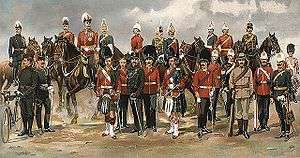
Prior to Confederation in 1867, the British Army, which included both "Fencible" Regiments of the British Army—recruited within British North America exclusively for service in North America—and Canadian militia units, was responsible for the defence of Canada. Some current regiments of the Canadian Army trace their origins to these pre-Confederation militia and Fencible units. Following the passage of the Militia Act of 1855, the Permanent Active Militia was formed, and in later decades several regular bodies of troops were created, their descendants becoming the Royal Canadian Horse Artillery, the Royal Canadian Dragoons, and the Royal Canadian Regiment. Regular Canadian troops participated in the North West Rebellion in 1885, Second Boer War, and, in much larger numbers, constituted the Canadian Expeditionary Force in First World War.[12]
On 19 November 1940, during Second World War, an Order in Council was issued that renamed the Permanent Active Militia as the Canadian Army (Active), supplemented by the Non-Permanent Active Militia, which was named the Canadian Army (Reserve).[4] The Army participated in the Korean War and formed part of the NATO presence in West Germany during the Cold War. In the years following its unification with the navy and air force in 1968, the size of Canada's land forces was reduced, but Canadian troops participated in a number of military actions with Canada's allies, including the Gulf War in 1991 and the invasion of Afghanistan in 2001, as well as peacekeeping operations under United Nations auspices in various parts of the world.[13]
Despite Canada's usual support of British and American initiatives, Canada's land forces did not directly participate in the Suez Crisis, the Vietnam War, or the Iraq War.[14]
Contrary to popular legend, Mayor Mel Lastman of Toronto was not the first customer that set the template for the domestic Army operations. In January 1999, the one meter of accumulated snow was deemed beyond the capabilities of the city's removal crews and the mayor "called in the cavalry".[15] The Army had done duty before then with at least two natural disasters: from sandbagging floods in Winnipeg[16] to cleaning up after ice storms in Operation Recuperation.[17] More recently, in 2019 New Brunswick was overcome with floods and the Army served the call.[18]
In April 2020, the civilians needed rescue service from the Army in Operation LASER, to help them with Long-Term Care Facility (LTCF)-resident senior citizens in Ontario and Quebec that fell prey to the COVID-19 pandemic in Canada.
Structure

Command of the Army is exercised by the Commander of the Canadian Army within National Defence Headquarters located in Ottawa. The Army is divided into four force generating divisions based on geography; the 2nd Canadian Division is based in Quebec, the 3rd Canadian Division is based in Western Canada, the 4th Canadian Division is based in Ontario, while the 5th Canadian Division is based in Atlantic Canada.[19]
The single force employing division, 1st Canadian Division, is part of the Canadian Joint Operations Command and is not under the command of the Canadian Army. It serves as a deployable headquarters to command a divisional-level deployment of Canadian or allied forces on operations, succeeding the previous Canadian Joint Forces HQ.[20]
In addition to the four regional command areas, the Canadian Army Doctrine and Training Centre, previously called Land Force Doctrine and Training System, commanded by a major-general and headquartered at McNaughton Barracks, CFB Kingston, Ontario, is responsible for the supervision, integration and delivery of Army training and doctrine development, including simulation and digitization. It includes a number of schools and training organizations, such as the Combat Training Centre at CFB Gagetown, New Brunswick, and the Canadian Manoeuvre Training Centre at CFB Wainwright, Alberta.[21]
Canadian infantry and armoured regimental traditions are strongly rooted in the traditions and history of the British Army. Many regiments were patterned after regiments of the British Army, and a system of official "alliances", or affiliations, was created to perpetuate a sense of shared history. Other regiments developed independently, resulting in a mixture of both colourful and historically familiar names. Other traditions such as battle honours and colours have been maintained by Canadian regiments as well.
Leadership
The senior appointment within the Canadian Army was Chief of the General Staff until 1964 when the appointment became Commander, Mobile Command in advance of the unification of Canada's military forces.[22] The position was renamed Chief of the Land Staff in 1993.[23] Following the reversion of Land Forces to the Canadian Army in 2011, the position became Commander of the Canadian Army.
Officers are selected in several ways:
- The Regular Officer Training Plan, where candidates are educated at the Royal Military College of Canada (RMC) or at civilian Canadian universities.
- Direct Entry Officer Plan, for those who already hold a university degree or technology diploma.
- Continuing Education Officer Training Plan, addresses shortages in certain officer occupations, and is intended to attract candidates who are otherwise qualified for service as officers, but who lack a degree. Candidates complete their degrees while serving in the Army.[24]
- University Training Plan (Non-Commissioned Members), designed to develop selected serving non-commissioned members for service as career officers in the Regular Force. Normally, candidates selected for this plan will attend RMC or a civilian university in Canada.[25]
- Commissioning From the Ranks Plan, provides officers to augment the number of officers commissioned through other plans and applies exclusively to those who have acquired some military experience and possess the necessary qualities that make them suitable for employment as officers.[26]
- Special Requirements Commissioning Plan, is designed to meet the needs of the officer occupations. It allows the Canadian Forces to profit from the skills and experience of senior non-commissioned members and may provide an opportunity for career advancement for selected deserving Chief Warrant Officers.[27]
- Subsidized special education, which includes the Medical Officer Training Plan or Dental Officer Training Plan.[28]
In addition there were other commissioning plans such as the Officer Candidate Training Plan and Officer Candidate Training Plan (Men) for commissioning serving members which are no longer in effect.
Occupational training for Canadian Army officers takes place at one of the schools of the Combat Training Centre for Army-controlled occupations (armour, artillery, infantry, electrical and mechanical engineers, etc.) or at a Canadian Armed Forces school, such as the Canadian Forces School of Administration and Logistics or the Defence Public Affairs Learning Centre for officers from career fields controlled outside the Army.
Regular force
There are presently three mechanized Brigade Groups in the Canadian Army's Regular Force. Approximately two-thirds of the Regular Force is composed of anglophone units, while one third is francophone. The mechanized brigades includes battalions from three infantry regiments, Princess Patricia's Canadian Light Infantry, the Royal Canadian Regiment, and the Royal 22e Regiment.
Between 1953 and 1971, the Regular Canadian Infantry consisted of seven regiments, each maintaining two battalions (except the Royal 22e Régiment, which had three; The Canadian Guards which had four battalions between 1953 and 1957; and the Canadian Airborne Regiment, which was divided into three commandos). In addition to the Canadian Guards, and the Canadian Airborne Regiment, The Queen's Own Rifles of Canada, and The Black Watch (Royal Highland Regiment) of Canada also fielded units that served in Regular Force.
In the years that followed the unification of the Canadian Armed Forces, several units of Regular Force were disbanded, or reduced to nil strength. On 15 September 1968, the 2nd Battalion, The Queen's Own Rifles of Canada was reduced to nil strength and transferred to the Supplementary Order of Battle. Several weeks later, The 1st Battalion of the Canadian Guards was disbanded on 1 October.
In 1970, several more units were reduced to nil strength. The 1st Battalion, The Queen's Own Rifles of Canada was reduced to nil strength and transferred to the Supplementary Order of Battle on 27 April, with the unit's personnel forming the 3rd Battalion, Princess Patricia's Canadian Light Infantry. Further reductions occurred from mid-June to early-July 1970, with the Regular Force unit from The Fort Garry Horse being disbanded on 16 June. The 1st and 2nd Battalions of The Black Watch (Royal Highland Regiment) of Canada were reduced to nil strength on 1 July, and transferred to the Supplementary Order of Battle. Several days later, on 6 July, the 2nd Battalion, The Canadian Guards were reduced to nil strength and transferred to the Supplementary Order of Battle; while its personnel became a part of 3rd Battalion, The Royal Canadian Regiment. After the Canadian Guards were reduced to nil strength, the role of the Household Troop reverted to the two seniormost infantry regiments of the Reserve. The respective battalions automatically relinquished its numerical battalion designation at that time.
During the 1990s, the Regular Force saw further organizational restructuring. The Canadian Airborne Regiment was disbanded in 1995,[29] while the Regular Force regiment of the 8th Canadian Hussars (Princess Louise's), formed in 1957, was converted to a mixed Regular and Reserve "Total Force" unit with the close-out of 4 Canadian Mechanized Brigade Group at Lahr, Germany in 1994, before reverting to a Reserve regiment in 1997.[30]
Reserve
The Army Reserve is the reserve element of the Canadian Army and the largest component of the Primary Reserve. The Army Reserve is organized into under-strength brigades (for purposes of administration) along geographic lines. The Army Reserve is very active and has participated heavily in all Regular Army deployments in the last decade, in some cases contributing as much as 40 per cent of each deployment in either individual augmentation, as well as occasional formed sub-units (companies). LFR regiments have the theoretical administrative capacity to support an entire battalion, but typically have the deployable manpower of only one or two platoons. They are perpetuated as such for the timely absorption of recruits during times of war. Current strength of the Army Reserve is approximately 18,000. On April 1, 2008, the Army Reserve absorbed all units of the former Communications Reserve.
Organization
Bases and training centres

- 2nd Canadian Division
- 2nd Canadian Division Support Base Montreal
- Garrison Valcartier
- Garrison St Jean
- 2nd Canadian Division Training Centre Valcartier
- 3rd Canadian Division
- 3rd Canadian Division Support Base Edmonton
- Garrison Wainwright
- Garrison Shilo
- 3rd Canadian Division Training Centre Wainwright
- 3rd Canadian Division Training Centre Detachment Shilo
- 4th Canadian Division
- 4th Canadian Division Support Base Petawawa
- Canadian Forces Base Kingston
- 4th Canadian Division Training Centre Meaford
- 5th Canadian Division
- 5th Canadian Division Support Base Gagetown
- 5th Canadian Division Training Centre Gagetown
- 5th Canadian Division Training Centre Detachment Aldershot
Equipment
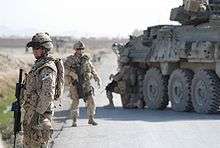
Canada is an industrial nation with a highly developed science and technology sector. Since the First World War, Canada has produced its own infantry fighting vehicle, anti-tank guided missile and small arms for the Army. Regular and reserve units operate state-of-the-art equipment able to handle modern threats through 2030–2035. Despite extensive financial cuts to the defence budget between the 1960s–2000s, the Army is relatively well equipped.[34] The Army currently operates approximately 10,500 utility vehicles including G-wagon and 7000-MV and also operates approximately 2,700 armoured fighting vehicles including the LAV-III and the Leopard 2.[35] The Army also operates approximately 150 field artillery pieces including the M777 howitzer and the LG1 Mark II.[36]
In the near future, between 2011 and 2017, the Army will receive a new family of tactical armoured patrol vehicles which will eventually replace the RG-31 Nyala and Coyote Reconnaissance Vehicle, known as the Textron Tactical Armoured Patrol Vehicle.[37] The dismounted soldiers will be equipped with the long-awaited Integrated Soldier System designed to improve command execution, target acquisition and situational awareness. The Army will receive a new family of engineering vehicles especially designed to clear pathways for troops and other vehicles through minefields and along roadside bombs and improvised explosive devices. This new family of vehicles will eventually replace the aging fleet of AEV Badger, ARV Taurus and AVLB Beaver.
The Army infantry uses the C7 Rifle or C8 Carbine as the basic assault rifle, with grenadiers using the C7 with an attached M203 grenade launcher, and the C9 squad automatic weapon.[38] The Canadian Army also uses the Browning Hi-Power and the SIG Sauer P226
Newer variants of the C7/C8 family have since been integrated into common use throughout the Canadian Armed Forces. The C7 has most recently been updated in the form the C7A2. The major internal components remain the same, however, several changes have been made to increase versatility of the rifle.[39]
Tactical communication is provided via the Iris Digital Communications System.
Meals
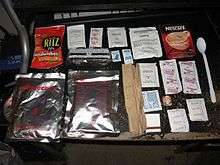
Field kitchens and catering are used to feed members of the Canadian Army personnel at bases and overseas operation centres. For personnel on patrol away from bases, they are supplied Individual Meal Packs (IMPs). The IMP is used by the Canadian Forces. Other types of rations are used by the Canadian Forces, notably fresh rations, or cooked meals provided directly from the kitchen or by haybox. There are also patrol packs, which are small high-protein snack-type foods (such as beef jerky or shredded cheese) and boxed lunches (consisting of assorted sandwiches, juice, fruit, pasta and a dessert) provided for soldiers to consume in situations in which meal preparation is not possible.
Uniforms
The Canadian Army maintains a variety of different uniforms, including a ceremonial full dress uniform, a mess dress uniform, a service dress uniform, operational/field uniforms, and occupational uniforms. Canada's uniforms developed parallel to that of the British from 1900 to the unification of the Canadian Armed Forces in 1968, though maintained significant differences. The adoption of a number of separate uniforms for separate functions, also made its uniforms become distinctively "Canadian" in the process.

Prior to unification in 1968, the uniforms between the three branches were similar to their counterparts in the forces of the United Kingdom and other Commonwealth countries, save for national identifiers and some regimental accoutrements. The Honourable Peter MacKay, Minister of National Defence, announced on 8 July 2013 the Government of Canada's intent to restore Canadian Army rank insignia, names and badges to their traditional forms.[40]
The Canadian Army's universal full dress uniform includes a scarlet tunic, midnight blue trousers with a scarlet trouser stripe, and a Wolseley helmet. However, a number of regiments in the Canadian Army are authorized regimental deviations from the Army's universal design; including some armoured, Canadian-Scottish regiments, and all rifle/voltigeur regiments.[41] The full dress uniforms of the Army regiments originated from the Canadian militia, and was eventually relegated from combat to ceremonial use.
The present service dress uniform includes a rifle green tunic and trousers, similar to the older iteration of the service dress, although with a different cut, and an added shoulder strap. The present service dress uniforms were introduced in the late 1980s, alongside the other "distinctive environmental uniforms" issued to other branches of the Canadian Armed Forces. From the unification of the armed forces in 1968, to the introduction of the distinctive service uniforms in the 1980s, the branches of the Canadian Armed Forces wore a similar rifle green service uniform.
The Canadian Army began to issue combat specific uniforms in the early 1960s, with the introduction of "combats," coloured olive-drab shirt. The olive-drab uniforms continued to be used with minor alterations until the Army adopted CADPAT camouflaged combat uniforms in the late-1990s. With the adoption of CADPAT, the Canadian Armed Forces became the first military force to adopt digital camouflage pattern for all its units.
Badge

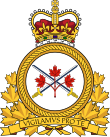
The badge of the Canadian Army consists of:[42]
- St. Edward's Crown
- Three red maple leaves on one stem
- Crossed swords
Rank structure
Military rank in the Canadian Army is granted based on a variety of factors including merit, qualification, training, and time in-rank. However, promotion up to the rank of corporal for non-commissioned members, and to captain for officers, is automatic based on time in previous rank. Some ranks are associated with specific appointments. For example, a regimental sergeant major is held by a chief warrant officer, or adjutant held by a Captain. In some branches or specific units, rank titles may differ due to tradition. A trained private within the Royal Canadian Armoured Corps is a trooper, whereas the same rank within the artillery is gunner. Other titles for the rank of private include fusilier, sapper, rifleman, craftsman, and guardsman.[43]
For a comparison of ranking structure, see Ranks and insignia of NATO. Not shown are the various appointment badges for specialist positions such as Base Chief Warrant Officer, Drum Major, etc.
Insignia
Commander-in-Chief
| Canada | Commander-in-chief |
|---|---|
| Insignia | .svg.png) .svg.png) |
| Title | Commander-in-chief |
| Abbreviation | C-in-C |
- Officers
The Canadian Army's naval-style insignia for commissioned officers has been replaced by the previous British Army style, effective August 2014, following the restoration of the Canadian Army name in 2011. The rank insignia for General ranks was reverted to the post-unification insignia in 2016. The Canadian Army rank structure is shown below.
| NATO code | OF-10 | OF-9 | OF-8 | OF-7 | OF-6 | OF-5 | OF-4 | OF-3 | OF-2 | OF-1 | OF(D) | Student officer | ||||||||||||||||||||||||
|---|---|---|---|---|---|---|---|---|---|---|---|---|---|---|---|---|---|---|---|---|---|---|---|---|---|---|---|---|---|---|---|---|---|---|---|---|
(Edit) |
No equivalent |  |
 |
 |
 |
 |
 |
 |
 |
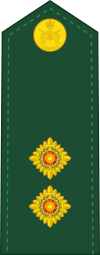 |
 |
.svg.png) |
No equivalent | |||||||||||||||||||||||
| General | Lieutenant-general | Major-general | Brigadier-general | Colonel | Lieutenant-colonel | Major | Captain | Lieutenant | Second lieutenant | Officer cadet | ||||||||||||||||||||||||||
| Général | Lieutenant-général | Major-général | Brigadier-général | Colonel | Lieutenant-colonel | Major | Capitaine | Lieutenant | Sous-lieutenant | Élève-officier | ||||||||||||||||||||||||||
- Non-Commissioned
| Senior non-commissioned member appointments of the Canadian Army | ||
|---|---|---|
| Canadian Forces Chief Warrant Officer | Army Sergeant-Major/
Command, Group Chief Warrant Officer |
Command, Group, Formation, Brigade, Garrison Chief Warrant Officer |
 |
 |
 |
| NATO Code | OR-9 | OR-8 | OR-7 | OR-6 | OR-5 | OR-4 | OR-3 | OR-2 | OR-1 | |||||||||||||||||||||||||||
|---|---|---|---|---|---|---|---|---|---|---|---|---|---|---|---|---|---|---|---|---|---|---|---|---|---|---|---|---|---|---|---|---|---|---|---|---|
(Edit) |
 |
 |
 |
 |
 |
 |
 |
 |
 | |||||||||||||||||||||||||||
| Chief warrant officer Adjudant-chef |
Master warrant officer Adjudant-maître |
Warrant officer Adjudant |
Sergeant Sergent |
Master corporal Caporal-chef |
Corporal Caporal |
Private (trained) Soldat (formé) |
Private (basic) Soldat (confirmé) |
Private (recruit) Soldat (recrue) | ||||||||||||||||||||||||||||
Publications
The Canadian Army produces two peer-reviewed academic journals including:
See also
Notes
- The Canadian Army originates from the Province of Canada's "Active Militia", created through the Militia Act of 1855. However, several Canadian Army units perpetuate the battle honours of Canadian units from the War of 1812.[2] The Active Militia was later adopted by the Canadian confederation through the Militia Act of 1868.[3] In 1940, an Order in Council was issued, renaming the active militias into the Canadian Army.[4] In 1968, the Canadian Army was formally amalgamated into the Canadian Armed Forces, serving as the forces' land component.
- Province of Canada (1855–1867)
- Total force describes a unit which includes both Regular and Reserve Force members.
References
- "An Act to regulate the militia of this province and to repeal the acts now in force for that purpose [microform]: assented to 19th of May, 1855". Archive.org. S. Derbyshire and G. Desbarats. Retrieved 26 March 2020.
- "War Of 1812 Battle Honours". www.forces.gc.ca. Ministry of National Defence. 14 September 2012. Retrieved 9 March 2020.
- Morton, Desmond (2009). A Military History of Canada. McClelland & Stewart. p. 91. ISBN 1-5519-9140-3.
- Stacey, Charles Perry (1955). "The Army Programme for 1941" (PDF). Official History of the Canadian Army in the Second World War Volume I: The Army in Canada, Britain and the Pacific. Ministry of National Defence (Canada). p. 89.
- "Canadian Army collection" (PDF). University of Victoria Special Collections: Introduction. 1899–1984. Retrieved 24 March 2020.
The Canadian Army was established in 1855 when the government passed the Militia Act, which provided for a paid, regular army consisting of active volunteer militia. Its forerunner was the militia dating back to 1651.
- "About the Army". Canadian Army. Government of Canada. Archived from the original on 12 July 2015. Retrieved 19 July 2015.
- "Canadian Army". Ottawa: Her Majesty the Queen in Right of Canada. 2013. Archived from the original on 2017-05-02. Retrieved 2017-02-14.
- "About the Army". Department of National Defence. Archived from the original on 16 July 2013. Retrieved 31 August 2010.
- Government of Canada, National Defence (2013-07-18). "Commander Canadian Army | About | Canadian Army". www.army-armee.forces.gc.ca. Retrieved 2019-09-21.
- Whitby, Michael; Gimblett, Richard H.; Haydon, Peter (2006). The Admirals: Canada's Senior Naval Leadership in the Twentieth Century. Dundurn. p. 285."Canadian Army". www.canadiansoldiers.com. Retrieved 2019-10-21.
- "Navy and air force to be royal once again". CBC News. 16 August 2011. Archived from the original on 10 November 2012. Retrieved 15 August 2011.
- "Soldiers of the First World War - CEF". Archived from the original on 7 September 2013. Retrieved 10 September 2013.
- "Canada in Afghanistan: Overview of Military and Development Activities". Archived from the original on 24 September 2013. Retrieved 10 September 2013.
- "Canada's 'No' To Iraq War A Defining Moment For Prime Minister, Even 10 Years Later". Archived from the original on 20 July 2013. Retrieved 10 September 2013.
- Kwong, Evelyn (14 January 2017). "20 years ago, Mayor Mel Lastman called in the Army for snow removal". The Toronto Star.
- "Canadian military rushes to Manitoba flood zone". CBC. 4 May 1997.
- "Looking back on the 1998 ice storm 20 years later". CBC. 4 January 2018.
- "Military here as long as needed, but flood-weary residents ready for return to normal". CBC. 29 April 2019.
- "Canadian Army reverts to British-style ranks and designations". Archived from the original on 11 September 2013. Retrieved 10 September 2013.
- "1st Canadian Division moves to CJOC". National Defence and the Canadian Armed Forces. Archived from the original on 21 November 2015. Retrieved 20 November 2015.
- Department of National Defence, 2011. Leader in Land Operations: LFDTS Land Force Doctrine and Training System
- Dr. Wilf Lund (n.d.) Integration and Unification of the Canadian Forces Archived 2010-01-15 at the Wayback Machine, CFB Esquimalt Naval & Military Museum, www.navalandmilitarymuseum.org
- Major Andrew B. Godefroy CD PhD (2007) Chasing the Silver Bullet: the Evolution of Capability Development in the Canadian Army Archived 2011-07-17 at the Wayback Machine, Canadian Military Journal, vol 8, no 1, pg 59.
- CF Military Personnel Instructions 09/05
- CFAO 9-13—University Training Plan—Non-Commissioned Members
- CFAO 11-9—Commissioning From The Ranks Plan
- CFAO 11-14—Special Requirements Commissioning Plan
- The Canadian Officer Selection System Archived 2016-04-10 at the Wayback Machine Retrieved 17 August 2011
- Canadian Forces Publication A-DH-267-003/AF-002—Part Two: Infantry Regiments
- Canadian Forces Publication A-DH-267-003/AF-001—Part One: Armour, Artillery and Field Engineer Regiments
- Godbout, Jacques N. "2e Division du Canada: Carignan out, Carpentier in [PHOTOS/VIDÉO] – 45eNord.ca" (in French). Retrieved 2020-04-12.
- "4th Canadian Division - Ontario". Canadian Army. 2020-03-17.
Mialkowski from 22 June 2019
- Government of Canada, National Defence (2016-06-29). "Canadian Combat Support Brigade - Canadian Army". www.army-armee.forces.gc.ca. Retrieved 2019-10-01.
- Lance W. Roberts (2005) 9.3 Military Forces, Recent social trends in Canada, 1960-2000, McGill-Queen's University Press, pp.372-376.
- Equipment: Vehicles Archived 2013-07-16 at the Wayback Machine, www.army.forces.gc.ca
- Equipment: Weapons Archived 2013-07-16 at the Wayback Machine, www.army.forces.gc.ca
- "Archived copy". Archived from the original on 2013-12-30. Retrieved 2013-12-29.CS1 maint: archived copy as title (link)
- Equipment: Weapons Archived 2012-06-14 at the Wayback Machine, www.forces.gc.ca
- "Canadian Armed Forces Assault Rifle". 2008. Archived from the original on 2012-01-28. Retrieved 2011-11-10.
- "Canadian Forces to go back to the future with British-style ranks". Archived from the original on 2013-07-10. Retrieved 2013-07-10.
- "6-1". Canadian Armed Forces Dress Instruction (PDF). Canadian Armed Forces. 1 June 2001. p. 211. Archived from the original (PDF) on 30 July 2018. Retrieved 11 June 2018.
- "Canadian Army". Public Register of Arms, Flags and Badges. Governor General of Canada. Archived from the original on 22 July 2015. Retrieved 12 January 2015.
- "canadiansoldiers.com article on Rank and Responsibility". Archived from the original on 2013-05-22. Retrieved 2013-06-27.
- Canadian Military Journal Archived 2011-07-06 at the Wayback Machine
- Canadian Army Journal Archived 2005-10-27 at the Wayback Machine
Further reading
- Kasurak, Peter. A National Force: The Evolution of Canada's Army, 1950–2000 (Vancouver: UBC Press, 2013)
External links
| Wikimedia Commons has media related to Canadian Army. |
- Official website

- Faces of War: The Canadian Army at Library and Archives Canada
- army.ca - Army.ca, a web forum and interactive wiki dealing with both current and historical issues related to the Canadian Army.
- Battle Honours in the Canadian Army by J.R. Grodzinski
- Canadiansoldiers.com
- Salute to the Canadian Army